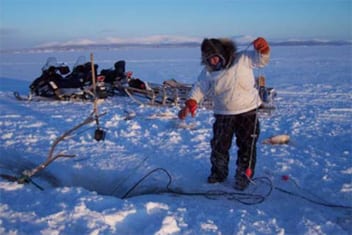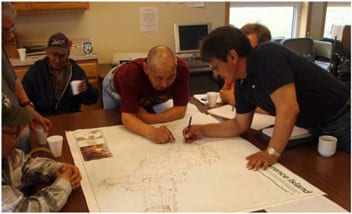Science and Mapping of Important Ecological Areas
 Oceana is working with a number of Arctic community-based organizations to identify Important Ecological Areas (IEAs). Information on the locations of important ecological and cultural areas provides a tool for guiding sustainable Arctic development and conservation. By making the information about these locations readily available, decision makers will be able to plan industrial activities accordingly to ensure that impacts to the ecosystem, including impacts to subsistence, are avoided or mitigated. Collaborating fully with local communities provides critical information to be included in this process, and provides decision making tools to community governments.
Oceana is working with a number of Arctic community-based organizations to identify Important Ecological Areas (IEAs). Information on the locations of important ecological and cultural areas provides a tool for guiding sustainable Arctic development and conservation. By making the information about these locations readily available, decision makers will be able to plan industrial activities accordingly to ensure that impacts to the ecosystem, including impacts to subsistence, are avoided or mitigated. Collaborating fully with local communities provides critical information to be included in this process, and provides decision making tools to community governments.
Important Ecological Areas (IEAs)
Oceana defines IEAs as geographically delineated areas which by themselves, or in a network, have distinguishing ecological characteristics, are important for maintaining habitat heterogeneity or the viability of a species, or otherwise contribute disproportionately to an ecosystem’s health, including its biodiversity, functioning, structure, or resilience. Examples include areas that are migration routes, subsistence areas, sensitive seafloor habitats, breeding and spawning areas, foraging areas, and areas of high primary productivity.
Combining Local and Traditional Knowledge (LTK) and “Western” Science with Maps
Oceana recognizes that LTK and “western” science are two separate but equally valid ways of knowing. Both describe the natural world, including its plants, animals, habitat, and their inter-relationships and natural cycles. Each are grounded in open-mindedness, honesty, inquisitiveness, repeated observations, pattern recognition, inference, and prediction. Using maps as a platform to bringing LTK and “western” science together adds new awareness and strengthens our understanding of the Arctic. Oceana and our community partners are applying these maps to build a more comprehensive understanding of the distribution of marine life in the Arctic.
A Transparent Analysis for Identifying Important and Sensitive Areas
To help identify IEAs, Oceana has developed an understandable and transparent analysis that can bring together different types of information about the ecosystem – such as subsistence areas, productivity, and distributions of various marine species – to better understand where there are biological ‘hot spots’ in the ocean. For example, a hot spot may be a place where fish, marine mammals, seabirds, and people all gather because it is a highly productive area. The analysis specifically identifies areas that are above average for multiple aspects of the ecosystem.
 Current Mapping and Research Efforts
Current Mapping and Research Efforts
Oceana is working on four Arctic mapping projects that cover the Aleutian Islands region, the Bering Strait, and the U.S. waters of the Beaufort and Chukchi Seas. In addition, we are preparing a manuscript for publication of our analytical tool and will produce a manuscript on using maps to combine LTK and “western” science. We will be presenting a part of our work at the Arctic Science Summit Week in April 2013.



